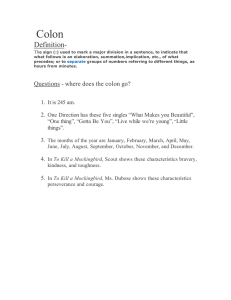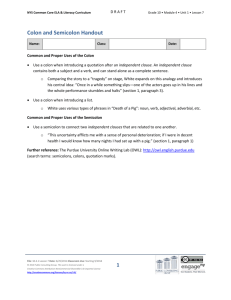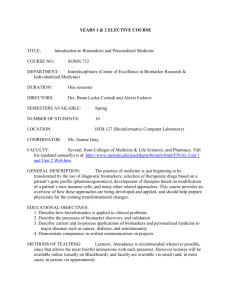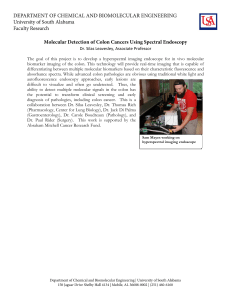your finger Hold out •
advertisement
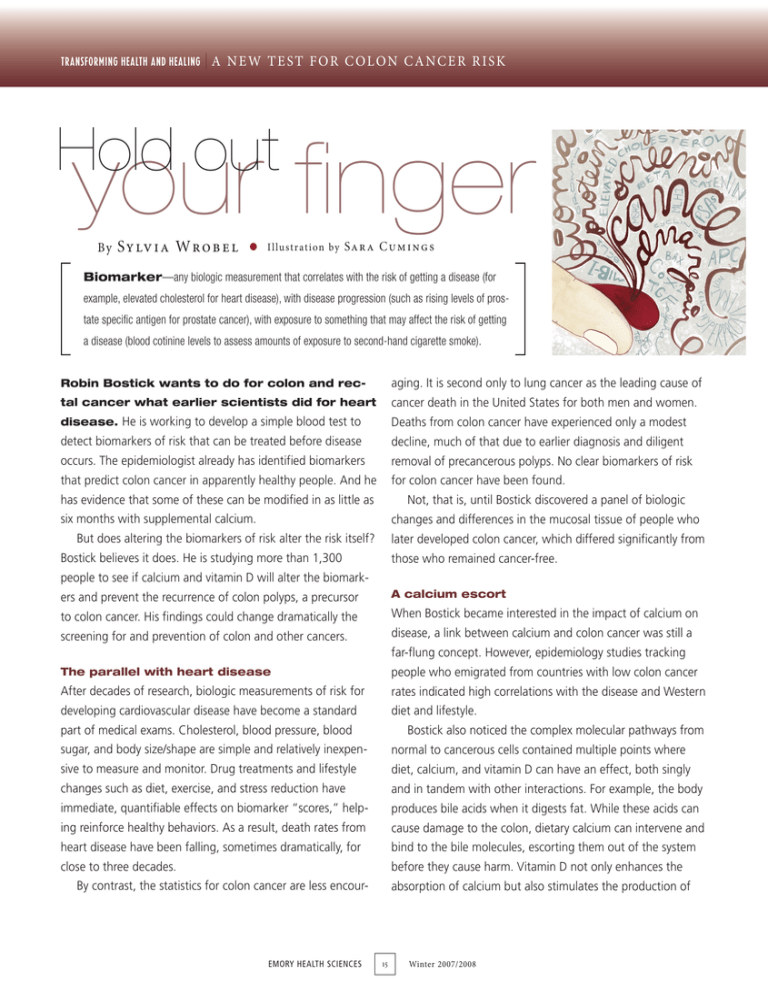
transforming feature Center health andof healing Attention A new test f o r c o l o n ca n c e r r i s k Hold out your finger By Sy lv i a W r o b e l • I l lu s t r at i on by Sa r a C u m i n g s Biomarker—any biologic measurement that correlates with the risk of getting a disease (for example, elevated cholesterol for heart disease), with disease progression (such as rising levels of prostate specific antigen for prostate cancer), with exposure to something that may affect the risk of getting a disease (blood cotinine levels to assess amounts of exposure to second-hand cigarette smoke). Robin Bostick wants to do for colon and rec- aging. It is second only to lung cancer as the leading cause of tal cancer what earlier scientists did for heart cancer death in the United States for both men and women. disease. He is working to develop a simple blood test to Deaths from colon cancer have experienced only a modest detect biomarkers of risk that can be treated before disease decline, much of that due to earlier diagnosis and diligent occurs. The epidemiologist already has identified biomarkers removal of precancerous polyps. No clear biomarkers of risk that predict colon cancer in apparently healthy people. And he for colon cancer have been found. has evidence that some of these can be modified in as little as Not, that is, until Bostick discovered a panel of biologic six months with supplemental calcium. changes and differences in the mucosal tissue of people who But does altering the biomarkers of risk alter the risk itself? later developed colon cancer, which differed significantly from Bostick believes it does. He is studying more than 1,300 those who remained cancer-free. people to see if calcium and vitamin D will alter the biomarkers and prevent the recurrence of colon polyps, a precursor A calcium escort to colon cancer. His findings could change dramatically the When Bostick became interested in the impact of calcium on screening for and prevention of colon and other cancers. disease, a link between calcium and colon cancer was still a far-flung concept. However, epidemiology studies tracking The parallel with heart disease people who emigrated from countries with low colon cancer After decades of research, biologic measurements of risk for rates indicated high correlations with the disease and Western developing cardiovascular disease have become a standard diet and lifestyle. part of medical exams. Cholesterol, blood pressure, blood Bostick also noticed the complex molecular pathways from sugar, and body size/shape are simple and relatively inexpen- normal to cancerous cells contained multiple points where sive to measure and monitor. Drug treatments and lifestyle diet, calcium, and vitamin D can have an effect, both singly changes such as diet, exercise, and stress reduction have and in tandem with other interactions. For example, the body immediate, quantifiable effects on biomarker “scores,” help- produces bile acids when it digests fat. While these acids can ing reinforce healthy behaviors. As a result, death rates from cause damage to the colon, dietary calcium can intervene and heart disease have been falling, sometimes dramatically, for bind to the bile molecules, escorting them out of the system close to three decades. before they cause harm. Vitamin D not only enhances the By contrast, the statistics for colon cancer are less encour- Emory Health Sciences absorption of calcium but also stimulates the production of 15 Winter 2007/2008 feature transforming Center health andof healing Attention A new test f o r c o l o n ca n c e r r i s k an enzyme that degrades Headed by Dartmouth’s John Baron, the study investigates bile acids. It also directly whether adding vitamin D to calcium supplementation will affects the cell cycle and reduce polyp recurrence. immune system. Bostick also won additional funding from the National Bostick became so Cancer Institute to piggyback biomarker research with this interested in this research study. The additional research will confirm whether treating that he made a life- biomarkers actually leads to decreased polyp occurrence in a changing decision to close large population. It also will examine questions such as if and his medical practice in how the biomarkers vary over time, whether they appear dif- Beaufort, South Carolina, ferently in different places in the colon, and if the biomarker and pursue a research career. That eventually led him to response to treatment varies in people with different vitamin Emory, where he is a Georgia Cancer Coalition scholar and a D receptors or in those taking nonsteroidal anti-inflammatory professor in the Rollins School of Public Health. medications. He has continued to hone in on identification of new biomarkers for colon cancer. Among these discoveries are Just a little finger prick early alterations in the genes involved in the normal structure Bostick is ready to take the next steps toward development of and function of the colon; subtle aberrations in the normal an effective biomarker screening test. That step involves a large growth, repair, and death cycle of the cells themselves; the prospective study of people who have never had a polyp, much appearance of inflammation; and the rise of potent growth less any sign of colon cancer, to determine if biomarkers can factors, hormones that stimulate proliferation and differentia- predict who will develop colon problems. As a part of this pro- tion of cells. cess, Bostick wants to develop a simple and easy test, such as identification of biomarkers in blood, urine, or mucosal tissue. Nanotechnology may enable him to make such tests fast Growing evidence Bostick’s hunch about the chemopreventive effects of calcium and cheap. Working with the quantum dot technology avail- is no longer a far-fetched hypothesis. In an initial groundbreak- able at Emory and Georgia Tech, he is creating software that ing study of 200 participants, he analyzed mucosal tissue to automatically scans slides to quickly and accurately quantify demonstrate that cell proliferation is a powerful biomarker of the presence and quantity of biomarkers in mucosal tissue. risk for developing colon cancer. He recently completed a study What used to take a researcher six hours can now be done by of the effects of calcium and vitamin D, separately and com- a machine in 15 minutes. bined, on a panel of biomarkers in 88 Emory Clinic patients If Americans followed the American Cancer Society’s rec- with precancerous colon polyps. The biomarkers are of pro- ommendations for regular colonoscopies, gastroenterologists tein expression such as p21 (colon cancer differentiation, or would be unable to meet the demand. While the finger prick maturation) and COX-2 (colon cell inflammation). Initial data screening test that Bostick envisions would not do away with analysis indicates that treating patients with both calcium and colonoscopies, a cheaper, easier biomarker test would more vitamin D has a synergistic effect on the biomarkers. likely be accepted and used by more people. The biomarker Although the approach works for biomarkers, will it work screening will provide better information on who needs a in clinical outcomes? Bostick and colleague Jack Mandel colonoscopy when and how often, and will provide additional are trying to find out as principal investigators of the South motivation for those who most need a colonoscopy to get Carolina and Georgia components of a multicenter study one, says Bostick. involving 2,457 people who have regular colonoscopies. Emory Health Sciences So get ready to hold out your finger. 16 Winter 2007/2008 •
